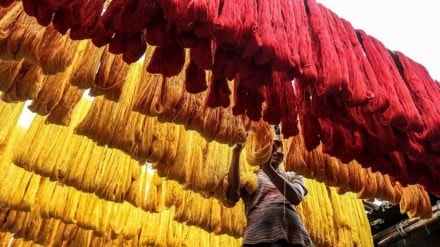A sharp drop in demand and higher production costs have forced dyestuff manufacturing units in Gujarat to cut production. The demand crunch is attributed to sluggish domestic consumption of textiles and apparels, and a fall in exports.
Dyestuffs are used to impart colour to a variety of products including textiles, paper, leather and plastic products.
Also read: Five emerging technologies and skills HVAC professionals in India need to master in 2023
According to industry sources, the Gujarat dyestuff units are currently operating at 50-60% of the total the capacity, resulting in significant job cuts. In normal times, the state accounts for 70% of the country’s dyestuff output.
Haresh Bhuta, President, Gujarat Dyestuffs Manufacturers’ Association (GDMA), said that the situation may worsen in the coming months. “The sector has been facing problems for around one year now. The main reasons include global circumstances and geo-political tensions around the world. Russia-Ukraine War and the tensions between the US and China have caused demand to go down in the EU region and the US, which were the biggest export destinations for the sector as well as the industrial users”, he said.
Bhupendra Patel, chairman, Gujarat Region, Chemical Export Promotion Council (CHEMEXCIL), said, “The pandemic and Ukraine-Russia war have caused the prices of coal, gas, and basic raw materials like caustic soda and benzene to go up significantly. This has increased the overall cost of production. To make matters worse, the pandemic has changed the consumption pattern of consumers.”
Gokul M Jaykrishna, joint MD & CEO of Asahi Songwon Colors, the largest producer of blue pigment globally, said, “The export market has been seriously hit. This year we have exported only around 50-60% of our production, which is around 15-20% lower on year.”
There are two main categories in pigments; AZO pigments which include pigments of red, yellow and orange colour, while the other is phthalocyanine pigments which include blue and green colors. Jaykrishna added, “India is the world leader in Phthalocyanine pigments but in Azo pigments, we are behind China. As the demand in the global market is low, we cannot do much to change that. But what can be done is that India can stop China from dumping their red and orange pigments in Indian markets with higher import tariffs or anti-dumping duties.”
Also read: Ajio registers 50% of total orders during its Big Bold Sale from tier-II, -III markets
According to the data released by the Union ministry of commerce and industry, the dyes and pigments sector witnessed a 20.18% decline in exports last fiscal. The exports stood at Rs 2,588.24 crore in FY23 against the Rs 3,242.49 crore in FY22.
